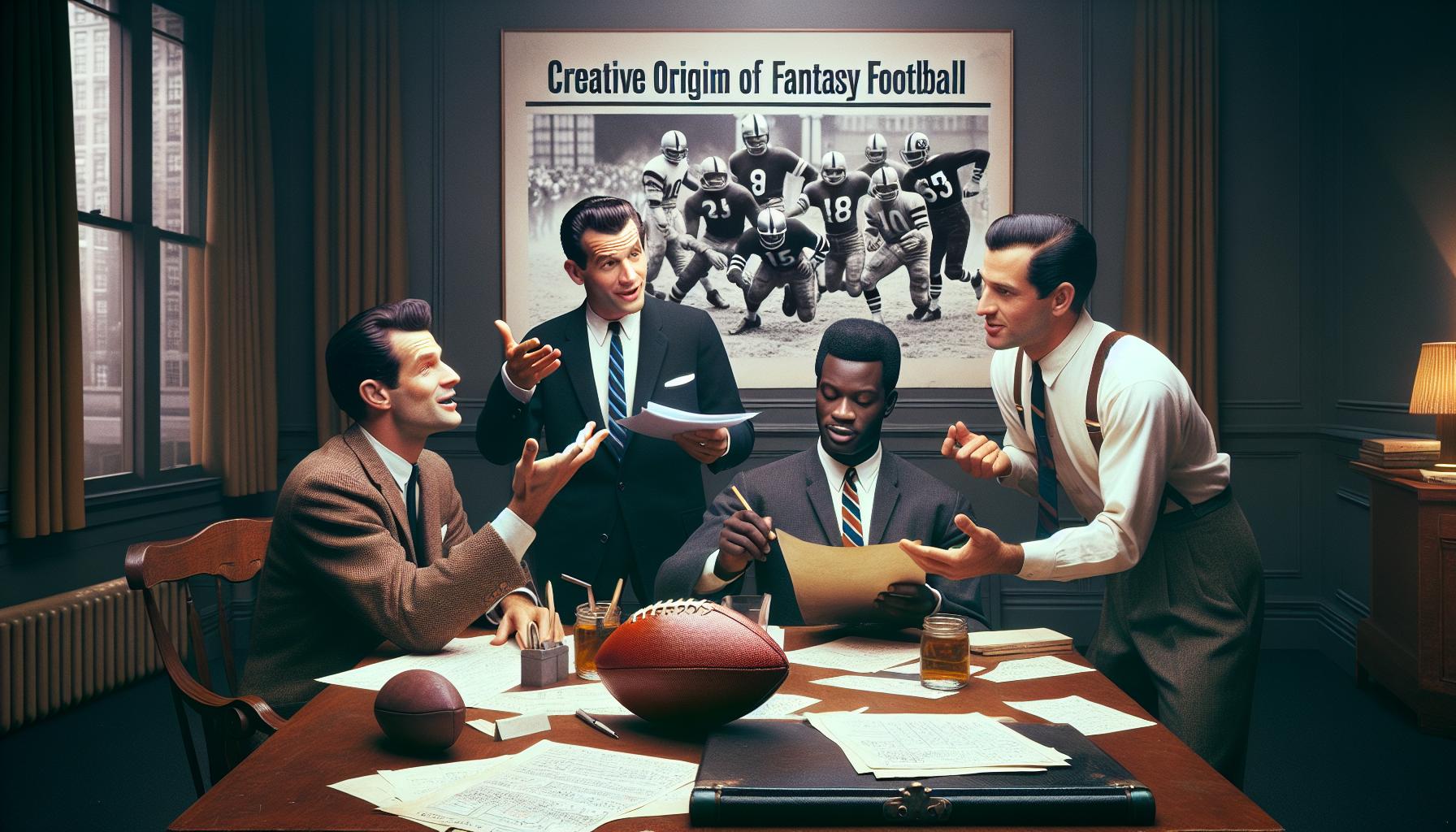Fantasy football has revolutionized how millions of fans experience America’s favorite sport transforming casual viewers into passionate virtual team owners. But while fans battle it out in weekly matchups today the game’s humble beginnings trace back to a group of football enthusiasts in the 1960s.
Enter Wilfred “Bill” Winkenbach a limited partner of the Oakland Raiders who alongside two sports journalists hatched an idea that would change football fandom forever. In a New York hotel room in 1962 they created the first-ever fantasy football league known as the GOPPPL (Greater Oakland Professional Pigskin Prognosticators League). It’s hard to believe that what started as a fun way to stay engaged with football would evolve into a multi-billion dollar industry captivating over 40 million players annually.
The Birth of Fantasy Football in Oakland
Fantasy football emerged in Oakland during a pivotal moment in 1962 when three sports enthusiasts gathered in a Manhattan hotel room during a Raiders’ road trip.
The Originators: Wilfred Winkenbach and Friends
Wilfred “Bill” Winkenbach, a limited partner in the Oakland Raiders organization, spearheaded the creation of fantasy football alongside Oakland Tribune sports editor George Ross and Tribune reporter Scotty Stirling. Winkenbach brought extensive experience in fantasy sports, having previously developed fantasy golf and baseball scoring systems in the 1950s. The trio spent several hours in Room 932 of the Manhattan Hotel crafting the fundamental rules that would govern modern fantasy football leagues.
The First Fantasy Football League: GOPPPL
The Greater Oakland Professional Pigskin Prognosticators League (GOPPPL) launched in 1963 with eight teams composed of AFL administrative personnel and Raiders season ticket holders. GOPPPL established core gameplay elements including:
- Draft processes for selecting NFL players
- Weekly head-to-head matchups between fantasy teams
- Point scoring systems based on touchdowns and field goals
- Trade regulations between team owners
- Free agent acquisition procedures
The inaugural GOPPPL draft took place in Winkenbach’s Oakland rumpus room, with the first-ever fantasy pick being George Blanda, then quarterback of the Houston Oilers.
Key Developments in the 1960s

The 1960s marked a transformative period for fantasy football as the game evolved from its Oakland origins into a broader phenomenon. The decade saw significant refinements in rules standardization and geographical expansion.
Setting the Initial Rules
The GOPPPL established foundational rules that shaped modern fantasy football in 1963. Players earned 25 points for touchdown passes 25 points for field goals over 50 yards 10 points for touchdown runs. The league implemented a structured waiver system allowing teams to claim released players based on priority order. Team rosters consisted of 20 players including quarterbacks running backs wide receivers kickers defensive players. The scoring system focused on touchdowns field goals extra points rather than yardage-based statistics.
| Original GOPPPL Scoring System | Points |
|---|---|
| Touchdown Pass | 25 |
| Field Goal (50+ yards) | 25 |
| Touchdown Run | 10 |
| Extra Point | 5 |
Growing Beyond Oakland
Fantasy football expanded beyond the Bay Area through media coverage in the Oakland Tribune. Sports journalists introduced the concept to their colleagues in other cities creating satellite leagues in Los Angeles San Francisco Chicago. The Andy Mousalimas Kings X Sports Bar in Oakland became the first public venue to host fantasy football leagues in 1968. The bar’s leagues attracted participants from different professions backgrounds creating a diverse fantasy football community. The game spread through word-of-mouth among sports enthusiasts newspaper readers bar patrons establishing regional variations of the original GOPPPL format.
Fantasy Football Goes Mainstream
Fantasy football experienced exponential growth during the 1980s and 1990s as technological advances made statistical tracking more accessible to the general public.
The Role of Print Media
Print publications revolutionized fantasy football accessibility in the 1980s. The Fantasy Football Index, launched in 1987, became the first nationally distributed magazine dedicated to fantasy sports. USA Today expanded fantasy coverage by publishing weekly NFL statistics, reaching 5.5 million readers. Sports magazines like Pro Football Weekly incorporated dedicated fantasy sections, providing player rankings, injury updates and statistical analysis. Football Digest offered specialized content for fantasy managers through regular columns featuring expert advice. Major newspapers integrated fantasy football segments into their sports sections, creating specialized weekly features that reached millions of readers across America.
The Rise of Stats Services
Specialized statistics services transformed fantasy football management in the late 1980s. CompuServe launched the first electronic fantasy sports service in 1985, delivering real-time statistics to subscribers. Stats Inc. introduced automated scoring systems in 1987, processing game data for fantasy leagues nationwide. The Fantasy Stats Bulletin Board System connected 2,000 fantasy players across the country in 1989. Electronic statistical services reduced manual calculation time from 6 hours to 30 minutes per week. Professional league operators emerged, managing hundreds of leagues through centralized scoring systems. These innovations laid the groundwork for modern fantasy platforms by standardizing scoring and establishing automated record-keeping protocols.
The Digital Revolution
The advent of the internet transformed fantasy football from a manual calculation system into a sophisticated digital experience. Online platforms automated scoring processes enabling real-time statistics tracking instant roster updates.
Yahoo’s Game-Changing Platform
Yahoo Sports launched its free fantasy football platform in 1999, revolutionizing accessibility to the game. The platform introduced automated scoring systems live stat tracking player news updates mobile apps. Yahoo’s interface allowed players to manage teams remotely draft online participate in mock drafts research statistics. By 2001, Yahoo’s fantasy football community grew to 1 million users establishing the platform as an industry leader. The service expanded to include customizable scoring options live chat features trade processing tools multiple league formats.
The Explosion of Online Fantasy Football
Online fantasy football participation surged from 2 million players in 2000 to 35 million by 2015. Major sports networks ESPN CBS Sports NFL.com launched competing platforms creating a robust digital ecosystem. These platforms integrated advanced features including:
| Year | Platform Innovation | Impact |
|---|---|---|
| 2003 | Live scoring updates | Real-time gameplay tracking |
| 2008 | Mobile apps | 24/7 team management |
| 2012 | Daily fantasy sports | Year-round engagement |
The digital transformation enabled cross-platform compatibility social media integration enhanced statistical analysis tools. Fantasy football websites generated $1.5 billion in annual revenue by 2015 through advertising premium subscriptions additional content services.
Modern Fantasy Football Industry
Fantasy football transformed into a sophisticated digital enterprise with advanced technology platforms serving millions of users worldwide. The industry generates billions in revenue through various business models including advertising premium subscriptions content services.
Major Players and Platforms
ESPN CBS Sports NFL.com dominate the fantasy football landscape with comprehensive digital platforms. ESPN leads the market with over 20 million active users across its fantasy sports offerings. CBS Sports differentiates itself through premium league management tools advanced analytics. NFL.com leverages its official status to provide exclusive content direct access to game data. DraftKings FanDuel revolutionized the space by introducing daily fantasy sports reaching valuations over $1 billion each. These platforms offer mobile apps live scoring customizable league settings player news updates draft tools trade processing automated waivers.
Economic Impact and Growth
The fantasy sports industry generates $9.5 billion in annual revenue with football accounting for 70% of the market. Here’s a breakdown of the economic impact:
| Metric | Value |
|---|---|
| Annual Revenue (2023) | $9.5 billion |
| Active Players | 50+ million |
| Average Spend per Player | $465/year |
| Market Growth Rate | 12% annually |
| Corporate Partnerships | $2.3 billion |
| Technology Infrastructure | $1.8 billion |
The industry creates 100,000+ jobs through direct employment content creation technology development marketing services. Major brands invest $2.3 billion annually in fantasy sports advertising sponsorships. Technology companies generate $1.8 billion from platform development data services mobile applications.
Conclusion
From its humble beginnings in a New York hotel room to today’s digital phenomenon Bill Winkenbach’s creation has transformed how millions experience football. What started as a simple game among friends has evolved into a multi-billion dollar industry that’s revolutionized sports entertainment.
Fantasy football hasn’t just changed how fans watch the game – it’s created an entirely new way to engage with the sport. The innovative concept born in 1962 continues to grow and adapt with technological advances making it more accessible and exciting than ever.
Today’s thriving fantasy football community stands as a testament to Winkenbach’s vision proving that sometimes the best ideas come from passionate fans who dare to think differently.




